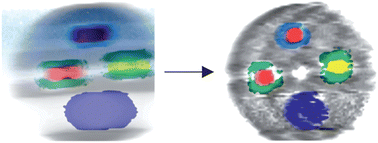Tomographic Energy-Dispersive Diffraction Imaging (TEDDI) enables a unique non-destructive mapping of the interior of bulk objects, exploiting the full range of X-ray signals (diffraction, fluorescence, scattering, background) recorded. By analogy to optical imaging, a wide variety of features (structure, composition, orientation, strain) dispersed in X-ray wavelengths can be extracted and colour-coded to aid interpretation. The ultimate aim of this approach is to realise real-time high-definition colour X-ray diffraction imaging, on the timescales of seconds, so that one will be able to ‘look inside’ optically opaque apparatus and unravel the space/time-evolution of the materials chemistry taking place. This will impact strongly on many fields of science but there are currently two barriers to this goal: speed of data acquisition (a 2D scan currently takes minutes to hours) and loss of image definition through spatial distortion of the X-ray sampling volume. Here we present a data-collection scenario and reconstruction routine which overcomes the latter barrier and which has been successfully applied to a phantom test object and to real materials systems such as a carbonating cement block. These procedures are immediately transferable to the promising technology of multi-energy-dispersive-detector-arrays which are planned to deliver the other breakthrough, that of one–two orders of magnitude improvement in data acquisition rates, that will be needed to realise real-time high-definition colour X-ray diffraction imaging.

You have access to this article
 Please wait while we load your content...
Something went wrong. Try again?
Please wait while we load your content...
Something went wrong. Try again?


 Please wait while we load your content...
Please wait while we load your content...